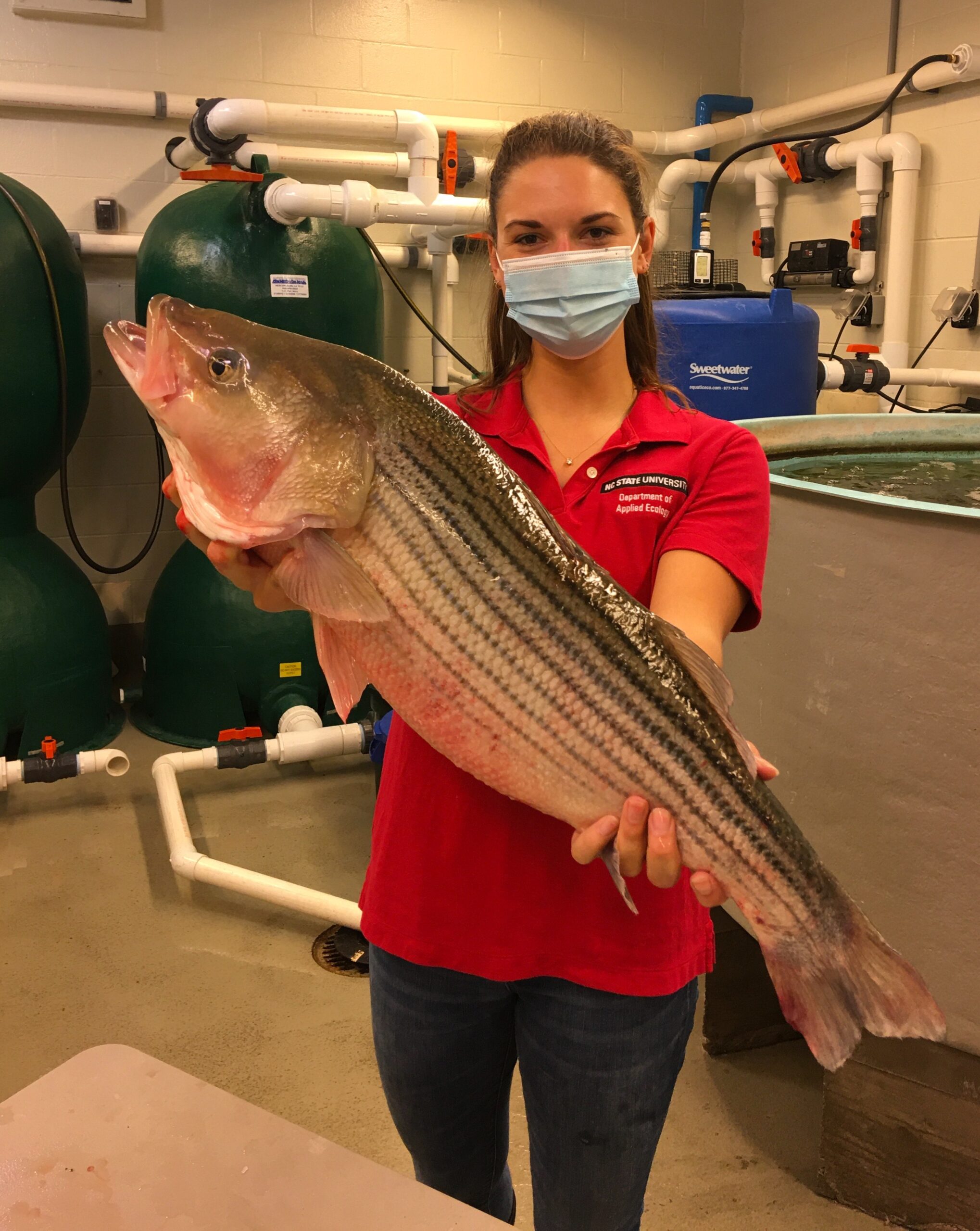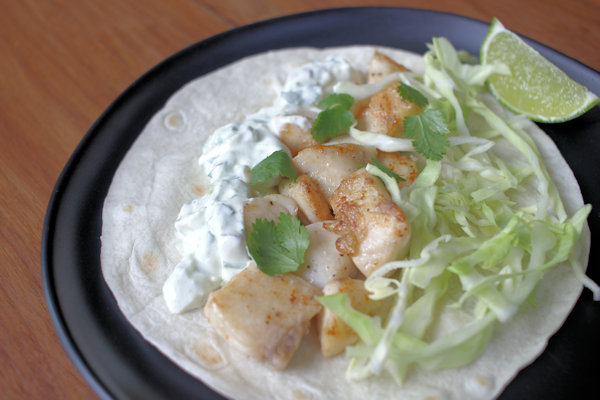Breakthroughs Position Striped Bass for Commercial Success
For Immediate Release
Contact:
Katie Mosher, kmosher@ncsu.edu
Scientists from NC State University have developed a method for farming striped bass more efficiently and less expensively than ever before. Unlike previous methods, the new process does not rely on hormones for breeding striped bass in captivity.
NC State’s Benjamin Reading says the method has enabled his team to produce 5 million larvae from a single spawning event with captive striped bass.
“That yield is the equivalent of what used to take the time and resources of an entire season’s effort for our team,” says Reading, who also serves as program coordinator for StriperHub, a National Sea Grant initiative to advance the commercialization of marine striped bass. “It’s a revolutionary change, and it suggests high potential for scaling up to commercial levels.”

Researchers at North Carolina Sea Grant and NC State University are collaborating with experts along the Atlantic Seaboard on StriperHub, and Reading says a growing striped bass industry will help address a $16 billion seafood industry trade deficit.
“Nine out of 10 seafood products that Americans consume are imported,” says Reading. “But there’s a significant untapped demand for marine striped bass — and this project can help to satisfy those consumers.”
Both striped bass and its hybrids find eager consumers at markets, restaurants and sushi bars.
“The early reception from consumers and servers of traditionally wild-caught striped bass shows they love the farm-fresh taste, too,” Reading says.
Since the 1980s, scientists at the Pamlico Aquaculture Field Laboratory in Aurora, North Carolina, have been domesticating hybrid striped bass, a species bred from white bass and striped bass.
Reading, who began working at the field lab in the early 2000s, says researchers probably would have raised domesticated striped bass from the start, instead of hybrid striped bass, if they had possessed the knowhow. When scientists did begin breeding captive striped bass, they had to rely on hormones to induce spawning.
“Our new method simplifies the whole process,” Reading says. “You don’t need two species on site. You also don’t need the hormones, which are expensive, require a prescription from a veterinarian, and are much more technically difficult to work with. Compare all that to just putting fish in a tank and letting nature go to work.”
In collaboration with David Berlinsky at the University of New Hampshire and others, Reading and his colleagues researched the effects of injecting half a sample of domesticated striped bass with hormones and found that doing so instigated the others to spawn. In addition to saving half the money and hassle, the team learned critical information: that hormone-free fish could spawn in captivity.
Later, the scientists determined that when they simulated the conditions under which wild striped bass spawn, the domesticated striped bass also spawned — even without administering any hormones whatsoever to any of the fish. The researchers say no one had reported accomplishing that feat with captive striped bass.

“Striped bass typically migrate from cold, salty estuary waters in winter and head upstream into warmer and fresher waters in springtime, when they spawn,” Reading explains. “We learned that when we mimic these changes — if we dial up the temperature and drop the salt content in our tanks — then boom.”
Reading’s team spent years refining and optimizing the process to increase production, determining that bringing 25 males and 25 females into a large tank could generate 5 million striped bass larvae in a single spawning. Two new research articles in the journal Aquaculture describe their findings.
“The process has come a long way,” says co-author Linnea Andersen, a Ph.D. student at NC State. “It’s become so standard for us, but when I first started on the project in 2017, we were developing this brand new approach.”
Because the hybrid striped bass industry reaps $50 million annually, the implications of a simpler and cheaper means of producing striped bass larvae are significant. Reading says the new, hormone-free method could seed the whole industry with as few as six or seven spawning events annually.
Not only does the new production method cut costs and reduce challenges, he adds, farm-raised striped bass can weigh in at 3 pounds apiece, twice the size of domesticated hybrid striped bass.
Frank López, North Carolina Sea Grant’s extension director, says such breakthroughs often require a long-term commitment.
“For years, North Carolina Sea Grant has been supporting striped bass aquaculture research and extension, including hybrids,” says López, who also serves as StriperHub’s principal investigator. “Through StriperHub, we’re disseminating new findings like these about state-of-the-art production techniques and tips. We’re also developing education and training programs, clarifying permitting and licensing procedures, and promoting outreach and visibility among producers and consumers of striped bass.”
Reading believes many farmers will see the value of diversifying their crop by also raising striped bass. “Our production of larvae at this level positions us well to supply producers of fingerlings,” fish at any early developmental stage that includes scales and working fins. “Producers can use the larvae to create fingerlings for distribution,” he says. “Last year, we also grew 150,000 fingerlings ourselves that we sent out to farmers in our state.”
In 2019 and 2020, Reading says StriperHub has supported bringing roughly 8,500 pounds of farm-raised striped bass to North Carolina markets — and the project continues to distribute 200 to 400 pounds every month during the pandemic.
Eric Herbst, North Carolina Sea Grant’s coastal aquaculture specialist, says having the Pamlico Aquaculture Field Laboratory as ground zero for cutting-edge research and practice also provides unique educational opportunities for college students.
“Students in aquaculture programs at Carteret Community College and Brunswick County Community College can observe and get valuable hands-on experience at the facility,” says Herbst. “Some of the field’s most innovative work is happening in our own backyard, and the next generation of fish farmer gets to see it first-hand.”
David Cerino, chair of the Aquaculture Department at Carteret Community College, collaborates on the project. Herbst says the facility provides students in his program invaluable experience in applied research, growing striped bass from fingerlings to market size in aquaculture systems at commercial-scale.
Reading says that although new research has answered many questions, many more still remain.
“Can we speed up the spawning process and make it even more efficient?” he says. “And what about wild striped bass? Can we do this with them?”
read “Methods of Domestic Striped Bass (Morone saxatilis) Spawning That Do Not Require the Use of Any Hormone Induction” in the journal Aquaculture
read “Volitional Tank Spawning of Domestic Striped Bass (Morone saxatilis) Using Human Chorionic Gonadotropin (hCG) and Gonadotropin Releasing Hormone Analogue (GnRHa)-Induced ‘Pace-Setting’ Females” in the journal Aquaculture
see also chapter 2, “Regulating Reproductive Cycles for Captive Spawning,” in the Fish Physiology series of Aquaculture, Volume 38
cook with the Mariner’s Menu recipe for Striped Bass Tacos with Creamy Guacamole
more about aquaculture


